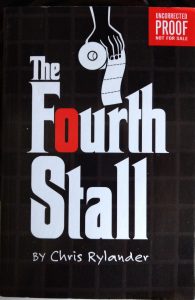If you want to launch your book with strong word of mouth and sales right out of the gate, then you need to do some groundwork months in advance.
That involves building your author website, starting your email newsletter list, posting excerpts or teasers, and putting up a listing on Goodreads.
Meanwhile, if you’re self-publishing, you also have to work on finalizing the cover, finishing the edits, getting everything laid out for print and digital editions… the list seems to go on forever!
So what is an ARC book? What is a galley book? And what’s the difference?
How Advance Review Copies Work
Of course, if you want to get a professional book review, you also need to think about that months in advance, too! Most professional trade reviewers require that you send your book in at least three months before publication, and often prefer four or five months’ lead time.
Yipes! You mean you have to have your book completely done almost half a year before you make it available for sale if you want professional reviews?
Well, yeah… kinda.
Professional reviewers like Publishers Weekly and Kirkus need a lot of lead time to get your book into the hands of the right reviewer, then let that person read it, digest it, and write a pithy 350-word review. Oh, and then it has to get edited and laid out for the magazine or posted online… so yeah, it takes a bit of time to get that pro review.
But while you have to send out review copies around four months before your book’s launch date, that doesn’t mean your book has to be totally done. Even massive traditional publishers don’t send out finalized copies of their books that far in advance. Instead, they send either galleys or ARCs for review.
What are those? Let’s find out!
What Is a Galley in Publishing?
- [source: Scholastic Inc.]
- [source: Scholastic Inc.]
Galleys are named for a printing tool, the galley, which was a metal tray that type would be inserted into by hand back in the day of hand-assisted mechanical printing. Galleys would be used to print one or two copies of a book for proofreading, which is how we came to use the term “galley proof” for a very rough printed proof of a book.
Galleys usually don’t have a finished cover; instead, they often have a placeholder cover, like a black cover with the title and author’s name printed in white in simple text.
Inside, the galley doesn’t have fancy layout or chapter graphics. It’s probably set in simple Times New Roman font and it’s basically thrown on the page.
However, the manuscript itself is basically done: it’s been edited and revised extensively. There may still be some typos or glitches—often, the galley is what the proofreaders are using to check the final draft and make sure that there are no errors or point them out if they need correcting.
Today, publishers tend to use PDFs for proofreading, so print galleys aren’t as common as they once were. However, most trade reviewers still accept them. That said, they frequently request that any book submitted in galley form that gets reviewed be followed up with two copies of the final print book.
ARCs
- [source: HarperCollins]
- [source: HarperCollins]
ARCs have largely replaced galleys as advance review copies. Depending on who you talk to, ARC stands for either Advance Reading Copy or Advance Review Copy.
These are print books made specifically to send out to reviewers before the book’s publication—they may have typos, the interior design might not be completely done, and the cover may only be partially finished.
For the most part, ARCs look very similar to the final book, though. The back cover might be specific to the ARC—they often include publicity information and ordering info—and the front might be stamped with NOT FOR RESALE or UNCORRECTED PROOF. The interior may have some work left to be done, too, and most ARCs come with a warning that they’re not in their final state and that typos and other issues may be present.
Again, ARCs have been edited and revised, and they’ve often even made it through a round of proofreading. Depending on the publisher, an ARC may be practically identical to the finished book or closer to a rough galley proof.
Big traditional publishers often print thousands of ARC copies to send out to trade reviewers, bloggers, booksellers, librarians, and other people who can generate word of mouth for the book.
In today’s technological environment, digital ARCs are gaining rapidly in popularity, sent out in email blasts and through various online services. ARCs are also used in giveaways and contests to give ordinary readers early access to books in an effort to build buzz.
Galley vs. ARC
Galleys are rough proofs of a book, while ARCs are nearly finished copies sent out to influencers before a book’s publication.
Both help build buzz for your book before it even launches, so you should definitely consider using them as part of your pre-publication marketing efforts to get more reviews.
Producing Your Own Advance Review Copy
If you don’t run a publishing company, it may seem a little pointless to produce an advance copy—you’d have to pay to get it printed, and some print-on-demand providers charge a fee to update the files you originally sent.
But with more trade reviewers now accepting digital review copies, it makes sense to create an early review copy of your book to send out, either in PDF or ePub format (the two most commonly accepted formats).
If you want even more options for getting early reviews from professional outlets, consider telling yourself that your publication deadline is actually four months sooner than it is. Get your book edited, finish your cover, the whole works.
Then have a couple of “proof copies” printed by your print-on-demand provider (like CreateSpace or Ingram) so that the book doesn’t actually get put on sale just yet. Send those to the review outlets you’re targeting, along with a thorough cover letter, and see what happens!
You don’t lose anything by finishing your book early. You can send out free ARC copies digitally to people on your email list to hopefully get them to start talking about it and writing early reviews, and you can use the few months between the review submissions and publication day to work on your marketing platform and maybe start writing the next book in your series.
If you’ve got that one ready to go—and out to reviewers—when launch day for your current book arrives, you’ll be well on your way to creating great momentum and building a sustainable author career.
Did you find this post helpful? Let us know in the comments below!
If you enjoyed this post, then you might also like:
- A Self Publishing Plan for Success: How to Achieve Your Dreams as an Author by Planning Ahead
- Why Every Author and Small Business Owner Should Be Building an Email List (and How to Do it for Free)
- 9 Amazon Book Promotion Programs That Can Help You Sell More Books Every Day
Kate Sullivan is an editor with experience in every aspect of the publishing industry, from editorial to marketing to cover and interior design.
In her career, Kate has edited millions of words and helped dozens of bestselling, award-winning authors grow their careers and do what they love!





You mentioned online services which publishers use for mass emails to reviewers. Which services are those? I’m asking in case I have to self publish. Thank you.
Hi David, two popular ones are aweber and mailchimp.
If you already have a PDF of the book. But it has not been published and will not be for about 9 months to a year. Can you send the PDF to book reviewers with the jacket cover?
Hi Eric, thanks for your question. Is your book traditionally published? I would ask your publisher
Should writers be concerned that if they send out their book in pdf format for a review, the book could be “stolen” from them and printed out by someone? Is there a standard message writers should add to their .pdf review copy saying something like “unauthorized reproduction or distribution is prohibited” ?
First, a disclaimer: I am in no way a lawyer. But here’s my two cents on this Joe. Your work is already copyrighted the moment you create it, even if you don’t formally register it with the relevant authorities. So even if you don’t add disclaimers or warnings to your manuscript, once you find someone has stolen it, you can definitely sue for damages. The legalities here would of course depend on your country’s copyright laws and such.
But I think thieves would more likely steal published works than unpublished ones, seeing as they’re more likely to profit from it. It’s still good to be diligent in protecting your works though.
Here is an article by Jane Friedman (who’s been in the publishing industry for decades) about this: https://www.janefriedman.com/idea-theft/
Thank you for the fantastic explanation
We’re so glad you found it helpful! :)
Thanks for this informative article. Is an ARC valuable without an index for a non-fiction book?
Hi Lahnice, I’m glad you found the article helpful! If you mean the book will have an index but it will be added to the final copy, I think the ARC can still be valuable without it.
This was immensely helpful. Thank you! Having difficulty finding a printing service that can print our galleys/ARC’s and ship them to various publications for review. Looking for recommendations on a printing service in the U.S.
-Thanks
We’re so glad you found the post helpful! :) We have a list of great printing companies here
Thanks so much, excellent information for a new author.
You’re very welcome! So glad you you found it helpful, Jerry :)
How should printed galley copies be bound? Comb, spiral, glued? Thanks.
Hi Steven, galleys are usually glued!
Thank you for this post. Exactly what I was looking to learn!
We’re so glad you found it helpful, Fred! :)